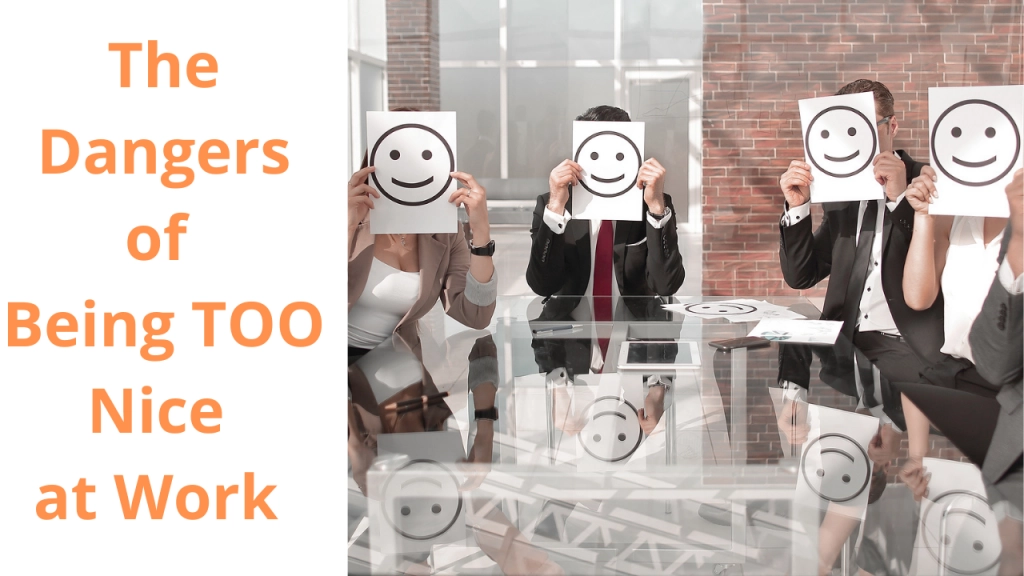Have you ever attended a meeting that wasn’t the meeting? Everyone was pleasant and agreeable in the room, but then filed off to engage in back-channel conversations and hold kangaroo courts.
This kind of charade is one of the many symptoms of a “nice” culture. But what’s touted as niceness is often nothing more than the veneer of civility, a cute nod to psychological safety, a hologram that falsely signals inclusion, collaboration, and high performance. In many of these cultures, leaders have simply spread a thin layer of politeness over a thick layer of fear.
There is the appearance of harmony and alignment but in reality there’s often dysfunction simmering beneath the surface that results in a lack of honest communication,
intellectual bravery, innovation, and accountability.

Why Organizations Pursue Niceness
The intention behind cultivating a nice culture is often genuine. In my experience, it’s common for organizations with a noble institutional mission, such as educational institutions, healthcare organizations, government bodies, non-profits, and voluntary associations to cultivate an environment of collegiality that emanates from their mission.
A benevolent purpose tends to foster a benevolent culture, and a benevolent culture tends to spawn niceness. For example, I worked with a biotechnology firm that had a deeply instilled mission to preserve patient safety. Ironically, that sense of compassion for patients mutated into a nice culture that drove truth-telling underground.
There are many reasons why leaders pursue niceness. Based on my experience working with hundreds of organizations and thousands of leaders over the past 20 years, here are the top four:
To avoid conflict and gain approval.
As a reflection of their own desire to be liked, leaders often avoid conflict and stigmatize dissent. They would rather be nice than offend, misbelieving that those are the only two choices.
Some organizations see niceness as a proxy for inclusion. They believe that to be nice is to be humane. When you see diverse employee populations self-segregate based on natural affinity groups, it could be an indicator of an unspoken “separate but nice” philosophy.
To show exaggerated deference to the chain of command.
In fear-based organizations, niceness keeps you safe. The logic is that if you don’t provoke the ire of those in power, you have a measure of job security.
To motivate people instead of holding them accountable.
Yes, interpersonal warmth creates a conduit of influence, but you still need accountability. I once worked with a highly affable CEO, who, to his eternal consternation, created a toxic nice culture in which people would hug each other and then not follow through on commitments.
The Dangerous Downsides of a Nice Culture
The adverse consequences of niceness are not simply inconvenient, they can be catastrophic for an organization. The downsides include:
Crisis activation.
At times, inertia becomes so strong in a nice culture that the organization loses its ability to act preemptively. People wait until a problem becomes too big to ignore.
How is it possible, that it took the University of Southern California more than 25 years to acknowledge and act on the sexual abuse claims against Dr. George Tyndall. A campus scandal, eventually
culminating in a staggering $1.1 billion settlement. I’ve personally worked with more than 30 universities and I’ve observed that they are notorious for putting low performers and bad actors in corners rather than directly addressing their performance. Nice cultures tend to nurture the false dichotomy that you can either be nice or you can hold people accountable, but not both.
Choked innovation.
By its very nature,
innovation disrupts the status quo. And yet it’s the lifeblood of growth. Innovation is also a social process that requires divergent thinking and courageous conversations. Pervasive niceness suppresses this process, creating an intellectual muzzle that can turn teams of exceptionally talented people into dysfunctional groups. I frequently work with institutions that desperately need to boost innovation but their nice cultures slow the speed of discovery.
Bleeding talent.
Talented people want to make a meaningful contribution. A-players want a healthy culture in which they can be rewarded for challenging the status quo. As one A-player who worked in a large pharmaceutical company said to me, “I’d rather work in an authoritarian toxic culture than a nice toxic culture because in the authoritarian toxic culture, they would at least tell me that I’m wrong when I challenge the status quo. I can provoke the system, force a reaction, and maybe that will lead to something. In a nice toxic culture, they humor you and then nothing ever happens.”
Low-velocity decision making.
In a nice culture, there’s pressure to go along to get along. A low tolerance for candor makes
the necessary discussion and analysis for decision making shallow and slow. You either get an echo chamber in which the homogenization of thought gives you a flawed decision, or you conduct what seem to be endless rounds of discussion in pursuit of consensus. Eventually, this can lead to chronic indecisiveness.
Learned helplessness.
An invisible norm of niceness can induce conformity, passivity, and
learned helplessness that lowers the bar of performance. I’ve listened to administrators and staff at top-tier universities complain bitterly about academe’s stultifying brand of politeness and how it destroys morale and extinguishes initiative. One university administrator told me that niceness has become a strait jacket that is putting institutional reform at serious risk. Instead of challenging the environment in hopes of improving the situation, people are throwing their hands up, and keeping quiet.

Combatting “Niceness”
There are several strategies you can employ to avoid the consequences above, creating a kind culture instead of a “nice” one.
Clarify expectations, standards of performance, and meeting types.
Ambiguity feeds toxic niceness, so clarify how you expect people to treat one another and
hold each other accountable.
Be explicit that you expect intellectual honesty, candid feedback, and tough questions. This change won’t be easy so it’s imperative that you clearly explain the organization’s current state, future state, and how the transition between the two will work. As soon as you communicate the new expectations, hold people accountable for violations.
Finally, when you have meetings, have an agenda and be explicit in explaining the type of meeting you intend to have. If you are there to discuss and decide issues, say so. If it’s an exploratory meeting to ideate and innovate, let everyone know up front. If it’s about communication and coordination, don’t keep it a secret.
Publicly challenge the status quo you helped create.
Don’t expect others to muscle through the fear and usher in a new era of truth-telling if you haven’t modeled the behavior first. You must be the first mover, demonstrating vulnerability and fallibility, and showing people that candor is rewarded. When others see you cast aside your ego defense mechanisms and pride of authorship for what you built in the past, it will give them courage.
Provide air cover for candor.
When people do have the courage to express dissenting views and speak candidly, protect them. Reduce the risk of ridicule by thanking those who do. As you accommodate dissent, you will gradually recast the norm until it becomes a cultural expectation.
Confront performance problems immediately.
When you don’t address a performance problem, you condone it. And if you hesitate to take action, you create confusion. Hold people accountable privately and respectfully. People who don’t respect these new boundaries have a choice to either adopt the new norm or find a new opportunity. The one thing they won’t do is retire on the job because it’s no longer an option.
Martin Luther King Jr. said in his famous
Letter from Birmingham Jail “…there is a type of constructive, nonviolent tension which is necessary for growth.” Don’t cover that up in your efforts to be nice. Channel and manage the tension. That’s real kindness.
Source: https://hbr.org/2021/06/the-hazards-of-a-nice-company-culture






